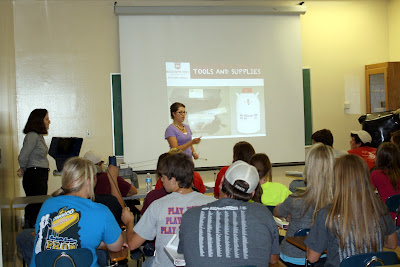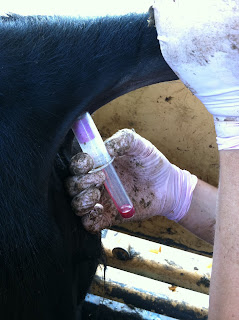I was able to interact with the campers when they came to the beef unit. We had a variety of activities planned and started out by explaining the difference between beef and dairy cattle and had some beef breeds on display in the barn for them to learn about. From there we talked about the production cycle of the cow by using the illustration developed by Explore Beef.com. Each camper got their own copy of the beef cycle along with the story explaining the illustration to take home. The "story" takes the reader through all the stages of the production cycle beginning with the cow-calf operation and the birth of the calf and ending with the beef on their dinner table at home or cafeteria lunch at school. We also talked about how Zinc, Iron, and Protein can power them through their day and help them them grow big and strong.
After reading through the cycle, we had a large scale that was big enough for multiple kids to get on and measured how big the calf would be a each stage. We started with a newborn calf having only one camper on the scale and ended with a market ready calf at 1200-1400 pounds. At that point we had over half the campers on the scale! This was a good way for them to be able to visualize the size of the calf throughout the cycle.
The kids on the scale for the market ready calf at 1295 pounds!
After talking about where their hamburger came from, we went on a little scavenger hunt to discover all the products that come from a cow other than beef. We hid about 30 items around the barn and let this kids find them. We had everything from chalk and jello to a tennis racket and deodorant! Once they found the items they used a big poster to figure out what part of the cow it came from. This part was very humorous - one camper, after discovering that part of the ingredients in deodorant come from fat, exclaimed, "Deodorant comes from fat??? It's a good thing I don't wear deodorant!" This is when I knew they were actually listening to what I was telling them!
The last activity we did with them, and probably their favorite, was letting each camper make their own "hamburger cookie". To do this, we used mini vanilla wafers (for the bun), mini oreos (for the patty), died coconut (for the lettuce), and yellow and red frosting (for ketchup and mustard). These were really yummy and the perfect snack to have out at the beef unit. While everyone was taking their turn making their burger, we talked about each component of the hamburger, where it comes from, and that every part of the burger comes from a farm! Who knew?? :)
YUM!
Step one: Put ketchup and mustard on the bun.
Step 2: put a "patty" on one bun and dip the other bun in the bowl of "lettuce".
Step 3: Mush the two buns together and wahlah - you have a cookie burger!
I thought the cookie burger was a really cool idea. It would be a cute demonstration for a beginner 4-Her. He/She could talk about each component of the burger, where it comes from, and the nutritional benefits of BEEF! This would be a good way for a youngster to promote agriculture! Would also be good for Ag in the Classroom and even cooler for a youngster to present this to their class and everyone make their own cookie burger. Many kids are unaware of where their food comes from and this is a handy dandy little tool to use to get that message across!



















































